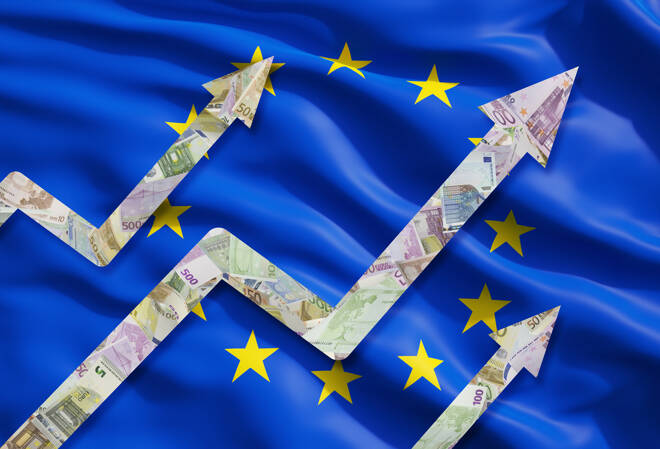Advertisement
Advertisement
European Equities: A Week in Review – 08/08/20
By:
It was a bullish week for the European majors. Economic data and corporate earnings delivered much-needed support.
The Majors
It was a bullish week for the European majors in the week ending 7th August. The DAX30 rose by 2.94%, with the CAC40 and EuroStoxx600 ending the week with gains of 2.21% and 2.03% respectively.
Corporate earnings and economic data provided direction in the week.
While lawmakers had failed to come to an agreement going into Friday, the hope of an agreement prevented a sell-off.
The Stats
It was another busy week on the Eurozone economic calendar.
In the 1st half of the week, July private sector PMIs from Italy and Spain were in focus. Finalized PMIs for France, Germany, and the Eurozone, and June Eurozone retail sales were also in focus.
The stats were mixed. While manufacturing sector activity picked up, service sector activity disappointed at the turn of the quarter, limiting the upside for the majors.
In July, the Eurozone’s finalized composite PMI came in at 54.9. This was up from a prelim 54.8 and June 48.5.
According to the finalized Eurozone Markit survey,
- It was the 1st time that the index has posted above 50.0 since February and grew at the fastest pace since June 2018.
- Both the manufacturing and service sectors reported growth in July.
- An easing in lockdown measures supported a first increase in new business in 5-months. Demand was undermined by continued weakness in international trade, however.
- New export business declined for a 22nd consecutive month.
- Firms cut staffing levels for the 5th month in a row
By country,
- France ranked 1st with a 29-month high composite PMI of 57.3.
- German (23-month high) and Spain (15-month high) ranked 2nd and 3rd.
- Italy sat at the bottom of the table in spite of a 24-month high composite.
In the 2nd half of the week, the focus shifted to Germany.
The stats were skewed to the positive. In June, factory orders surged by 27.9%, with industrial production rising by 8.9%.
In spite of the weakness in international trade, Germany’s trade surplus widened from €7.5bn to 14.5bn in June.
From the U.S
It was also a mixed bag on the economic data front.
Key stats were positive, however. July’s ISM manufacturing and Non-Manufacturing PMIs saw increases in July. The all-important ISM Non-Manufacturing PMI rose from 57.1 to 58.1. Factory orders and initial jobless claims figures were also positive.
With plenty of market sensitivity to labor market numbers, initial jobless claims eased back to 1,186k in the week ending 31st July. In the week prior, claims had stood at 1,435k.
At the end of the week, the focus then shifted to July’s nonfarm payrolls and the unemployment rate. A better than expected rise in nonfarm payrolls and a fall in the U.S unemployment rate to 10.2% delivered support on Friday.
The Market Movers
From the DAX, it was a mixed week for the auto sector. Daimler rallied by 8.61% to lead the way. BMW and Volkswagen ended the week up by 1.19% and by 6.58% respectively. Continental bucked the trend, however, falling by 1.30%. A 3.28% slide on Friday delivered the loss for the week.
It was a bullish week for the banking sector, however. Commerzbank rallied by 9.68%, with Deutsche Bank rising by 3.03%.
From the CAC, it was also a bullish week for the banks. BNP Paribas and Credit Agricole rallied by 3.99% and by 3.94% respectively. Soc Gen saw a more modest 2.47% gain on the week.
It was a particularly bullish week for the French auto sector. Peugeot rallied by 5.50%, with Renault surging by 13.46%.
Air France-KLM jumped by 10.20%, with Airbus up by 11.76%.
Travel stocks were on the move as the U.S announced an end to its blanket travel ban.
On the VIX Index
It was a 2nd consecutive week in the red for the VIX, which saw its 7th week in the red out of 8. Following on from a 5.34% loss from the previous week, the VIX fell by 9.20% to 22.21 in the week ending 7th August.
The S&P500 and the NASDAQ ended the week up by 2.45% and by 2.47% respectively, with the Dow rallying by 3.80%.
Economic data and corporate earnings delivered the upside in the week.
Geopolitics was negative for the majors, however, limiting the upside in the week. The tension between the U.S and China and fresh tariffs on certain Canadian aluminum goods tested support. There was also a lack of progress towards the U.S stimulus package.
The Week Ahead
It’s a quieter week ahead on the Eurozone economic calendar.
In the 1st half of the week, ZEW’s August economic sentiment figures for Germany and the Eurozone will be in focus.
The markets will then need to wait for 2nd estimate GDP numbers for the Eurozone on Friday.
Other stats in the week include Eurozone industrial production and trade data and member state inflation figures.
We would expect these to have a relatively muted impact on the majors.
From the U.S
It is another busy week ahead.
June’s JOLTs job openings on Monday and inflation figures on Tuesday and Wednesday will garner some interest.
In the 2nd half of the week, the focus will shift to the weekly jobless claims on Thursday.
July retail sales, industrial production, and August consumer sentiment figures on Friday wrap things up.
From Elsewhere
Industrial production and fixed asset investment figures from China will also influence on Friday.
Away from the economic calendar, geopolitics, COVID-19, and Brexit will need monitoring throughout the week.
About the Author
Bob Masonauthor
With over 28 years of experience in the financial industry, Bob has worked with various global rating agencies and multinational banks. Currently he is covering currencies, commodities, alternative asset classes and global equities, focusing mostly on European and Asian markets.
Advertisement
